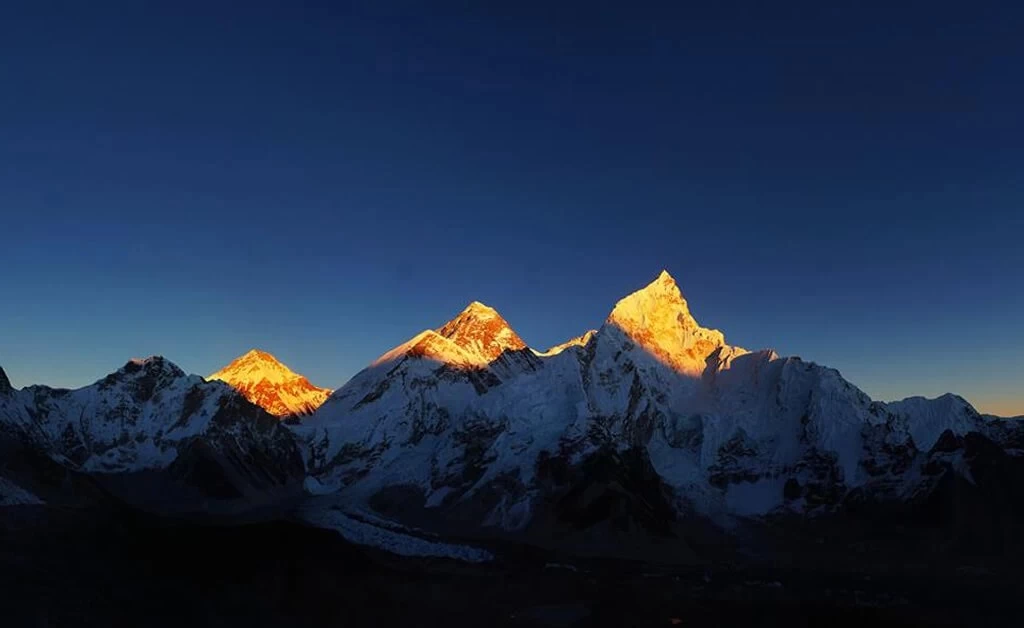The History of the Everest Base Camp Trek
The fabric of the Everest Base Camp Trek is sewn through several yarns exploring tales, cultural importance and an experience that no self-respecting adventurer can shy away from. The original source for the voyage itself dates back to the mid last century, at a moment when where Mt Everest was put on humanity radar in traditionally. British mountaineers became interested in the early 1920s and Everest began to attract a diverse number of both serious amateurs, professionals as well such others were part-time adventurers or organizers. It was the desperate pursuit of Mallory and previous explorers, such as George Mallory (no relation) and Andrew Irvine that meant these men never returned but also guaranteed the mountain would be explored more thoroughly in future.
Everest base camp trekking was popularize especially after the historic ascent to the summit by Sir Edmund Hillary and Tenzing Norgay in 1953.The trip starts right from Lukla, The small airstrip of lukla made easy access for everestlodging during Namche Bazaar – means it heart of handshakes. This incredible feat not only grabbed the attention of world but also was a kickstart for more trekkers and climbers to repeat them. Soon enough, the path to base camp became a popular trekking route for people wanting to onlook at and revel in spirit of Khumbu’s awesome environments as well as observe Sherpa culture up-close.
The requirements of the popularity have given rise to infrastructure. Teahouses and lodges were developed across the route offering basic food, shelter to sleep for trekkers. It caused an economic boom for the Sherpa people who came from Nepal to serve this burgeoning industry and provided them with a global forum in which they could share their culture & traditions of hospitality. The famously resilient and skilled Sherpa people became a pivotal part of the trek, sharing their knowledge.]
Now, as time passed by the Everest Base Camp Trek has been developed making it more accessible with modern amenities and trail improvement. Nonetheless, rooted in tradition as it is — trekkers still enjoy the ageless splendour of Himalayan landscape. Not only do you get amazing views of Everest and its neighbours on this trek, but a fundamental connection to the land which is inherited by nature.
Over the last decade or so, it has become a rallying point for debates about environmental conservation and sustainable tourism too. Growing numbers of trekkers mean more attention to the area’s delicate ecosystems and a number of initiatives are shaping up to reduce environmental impact. Romantic Mountaineering attempts to protect the unspoiled majesty of High Asia On Short Amount with preservation mindfulness and care for local way of life adjusts gutsy accomplishment with a responsible course
The Everest Base Camp Trek of today New.Corestand as an epitome of the human spirit and beings in search for adventure with ornamented by thousands, annually trying to trek into the raw beauty that encompasses these parts along their pilgrimage through time testamentA passed down journey up high on a trail of infinity. The history behind This hiking is More than a means to an end, It’s about the trail forged in some of God richest Country.
Everest Base Camp Trek Overview
One of the most iconic treks in the world, certainly one of bucket-list status, is The Trek to Everest Base Camp. This High-altitude trek in the Indian Himalayas takes adventurers to base camp of Mount Everest — The highest peak on Earth. Taking between 12 to14 days, the journey provides stunning scenery mixed with diverse cultural experiences and hair-raising challenges. From Lukla, trekkers make their way up through beautiful Sherpa villages and dense forests to meadows interlaced with alpine wilderness under towering peaks looming large on the distant horizon.
The real magic of the trek is to be able to experience Sherpa culture by walking on foot. During your trek, you will also come across welcoming locals, with traditional lifestyles and immense spiritual beliefs as we gain elevation. There is more to this than just physical challenge as it also provides experience into the culture of the Sherpa people famous for their bravery and astounding mountaineering abilities.
The trek incorporates acclimatization days to help the trekkers get used of the high altitudes so that they can prevent from getting sick easily. It is studded with major halts — Namche Bazaar, Tengboche and Dingboche offer a range of experiences backed by breath- stealing panoramas In summary, Everest Base Camp Trek is an adventure of a lifetime for those who long to communicate the magnificence and tradition lifestyle along with revel in the splendour that defines All Nepal.
Early Excursions on Everest
As expeditions in the first half of the 20th century to Everest become trials conducted by bold explorers with incredible motivation, these daring ventures led way for an era of mountaineering. Prime among them was interest in the world’s highest peak, and explorers began to test more than ever before what humans could do. Therefore, during the 1920s, British expeditions (notably led by George Mallory and later John Noel) began probing into Tibet to undertake its surveying. Deception Island 9 Jan For nearly the entire day, these expeditions manifested extraordinary endurance in hazardous environments and harsh weather conditions.
Despite their efforts, early expeditions were beset with problems and Jules remained elusive. The efforts mostly failed but they did give some useful information about the geography of the mountain, and also how difficult it could be thus providing crucial knowledge for future expeditions. The whole notion of Mt Everest being conquered got into the heads of adventurers worldwide and changed it to a symbol representing human endurance & spirit.
This interest would continue for the rest of the 19th and early-20th centuries, which saw more organized (and better equipped) expeditions being launched. The early explorers were not only trying to climb the mountain, they are also looking for answers inside it. Their legacies, however, spurred the pursuit of many other dreams into those mountains that culminated over generations to transform not just climbing techniques and equipment in a monumental way. The nitty-gritty of these pioneering efforts laid the groundwork for what was to come, resulting in a history so storied that those who came later are still prompted forward by it.
Sherpa Culture and Origin
The culture of Sherpa is integrated well with the Everest Base Camp Trek and they follow the traditional customs, traditions as per their spiritual belief. Sherpas moved to the Solu-Khumbu area in Nepal from Tibet, where they had first settled over 500 years ago. From this adaptation to the harsh Himalayan environment has emerged a special brand of culture: one that prizes evolution, community and reverence for nature.
Sherpas are famously experienced mountaineers who have long served as expert guides, typical to the area with an exceptional sense of direction at high altitudes and rugged terrains. In addition to their deep understanding of the mountains, they have a strong spiritual connection based on Tibetan Buddhism. Very traditional monasteries, prayer flags and sacred sites can be found along the trekking routes as proof of their closeness with both spirituality and nature.
Sherpas have a lot in common with Local Tibetans and community life is integral, embodying strong family values of group support. The festivals such as Losar (Tibetan New Year) represent colorful traditions, music and dance enhancing a feeling of pride in ones identity. Getting a start on the trails, trekkers are greeted with Sherpa hospitality and insight into one way of life which revolves around simplicity and connection to land.
Currently, in the trekking industry, Sherpas are not just limited to being guides but also as ambassadors of their culture. Not only does this enrich the trekking experience, it preserves their legacy and guarantees a self-sustainable future for their villages under rising tourism.
First Successful Ascent of Everest (1953)
In 1953, the first successful ascent of Mount Everest became a historic milestone for explorers and climbers. This journey to the highest peak in the world was led by Sir John Hunt, following a wave of n attempts after many previous ones which had failed over various decades. Among the team were distinguished climbers, Sir Edmund Hillary from New Zealand along with Tenzing Norgay a renowned Sherpa.
In April 1953, the expedition began but not without difficult challenges such as harsh weather conditions, treacherous landscapes and most of all – altitude. On May 29, 1953 after weeks of preparation and acclimatisation Hillary climbed with Tenzing to the summit. Around 1130am they made it to the top at an elevation of 8,848 meters (29,029 ft) above sea level and were now declared as having been there / doing that.
Approximately 4000 men and women have successfully made it to the top of Mt Everest (which is still considerably fewer than those who have won at poker online), but on May29th, 1953 Sir Edmund Hillary and Tenzing Norgay became part of a very select group. Their accomplishment rocked the world and had people all over being inspired adventurers too, for Everest became a symbol of human ambition. This historic ascent set the stage for future climbs, as well as underscored the critical role that Sherpas would come to play in mountaineering.
The duo made their successful climb on 29th May and after the first ascent, that particular sector of Everest tested with international fame hence followed plenty tourism development finally evolving into what we now know as Everest Base Camp Trek. Their legend endures, as a living testament to the ascension of man and mankind’s eternal fascination with highest point on Earth.
The trekking route commenced on the green flanks.
The journey of the trekker to Everest Base Camp has experience a historical transformation, making it one of besought and reachable treks in the world. In the beginning, this path was used first and foremost by Sherpas from the region where there is both aspirant tours inclined to climb up Mount Everest. Following Sir Edmund Hillary and Tenzing Norgay’s successful Everest summit in 1953, interest in the mountain grew, so this trail changed to cope with more trekkers on their way up.
The next few decades brought the need for infrastructure improvements. Tea-houses, lodges were established on the trail that helped trekkers rest in a comfortable environment which enhanced their experience as well. The options not only sheltered me but also allowed for local interaction granting an intimate glimpse into the lives of many wonderful Sherpa peoples.
The trekking route is well-marked as the trails pass through picturesque landscapes, be it dense forests or glacial rivers and charming villages. Essential stops along the trail, like Namche Bazaar and Dingboche provide important acclimatization points that help trekkers to adjust gradually.
Sustainable tourism and environmental protection are words which are increasingly being heard in recent years. There are also some program and guidelines for the eco-friendly trekking, such as waste management programs or responsible tourism. This development and subsequently commitment, all of this indicates at the evolution conversation among preserving unharmed beauty that surrounds us in Ladakh without allowing it to be locked away for good by our undulating tracks.
Our Everest Base Camp Trek today is a work done by man and proof of the tradition brought from one century to another, about connection nature in all unusual forms; it gives an implied glimpse upon attaining one’s dream amidst stories of exploration, fortitude, adventure seekers that courageously repeated ascents up those slopes over time.
Base Camp Set up: Historic Wins Withera
Everest Base Camp is a trekking spot that has marked its presence since longtime in the history of mountaineering and exploration. For much of the 20th century, Base Camp was only a staging point for climbers aiming to scale Everest but it rose in popularity over the latter part of that. By the early 1920s, formal expeditions to Everest like those led by George Mallory and later John Hunt had established a basis for further discovery that drew even more attention to explore the region.
The turning point was in the wake of Sir Edmund Hillary and Tenzing Norgay’s historic ascent of Everest (1953). The success went on to draw worldwide attention and transformed Base Camp into an icon of adventure. Over the next several years, a steady trail to Base Camp drew trekkers keen on observing some of the grandest landscapes and Sherpa culture around.
By 1960s,70s more tea houses has build and the route become open for little bit.omg. This evolution turned Base Camp from an isolated base station to a busy hub for trekkers and climbers. Everest Base Camp thus was then both a set destination and stepping stone, now conscripted as an indenture of anyone who dared embark upon the Himalacist duty-bound pilgrimage. The way to Base Camp now through the area is itself a historical record of one step in Nature mingling with Culture supporting Human Desire.
Tourist Travel Impacts on the Area
Tourism has changed completely the economy, culture and environment of the Khumbu region in which lies Everest Base Camp. Everest and the surrounding region has attracted trekkers and climbers since Tenzing Norgay Sherpa of Nepal and Sir Edmund Hillary of New Zealand made their first successful ascent along the southeast ridge in 1953, starting a steady flow into one of Earth’s most visually stunning but harsh locales. Tourism has expanded in the region attracting many trekkers, climbers and those seeking adventure who come here to explore landscapes and forests as well as visiting Buddhist monasteries located Throughout Khumbu (the incoming valley of Mount Everest). This mass influx of visitors provides major economic opportunities for local communities, particularly Sherpa people who have transitioned their subsistence economy into offers services catering widely tourists.
Teahouses, lodges and shops have sprung up along trekking routes generating employment for the locals enabling them to support their families. With the revenue generated from tourism, communities have been able to invest in education, healthcare and infrastructure which has improved quality of life. But with tourism now booming, so too come challenges. We may create an environmental strain through deforestation, build-up of litter and overuse of local resources.
In addition, the cultural landscape is changing traditional practices have been in contact with modern tourism. This notion of attracting more economic activity while balancing preservation and cultural factors is a conundrum that the Interlaken region continues to grapple with. In fact, there are some growing sustainable tourism initiatives in place looking to do just that while making sure the local community will benefit. Hopefully, the future of tourism in Everest lies somewhere in between adventure and sustainability.
Important Ascents and Climbers
The Everest Base Camp history is distinguished by several memorable expeditions and climbers that have had a hand in creating the mountain’s lore. Various teams have tried to reach the top since those early 20th-century attempts, every step of which contributes to that grand tale of exploration. The 1953 British expedition, headed by Sir John Hunt was particularly momentous after its summiting Edmund Hillary and Tenzing Norgay. Having achieved this world-breaking feat, the mountain not only created headlines all over but also ensured that nobody was able to look past its status as a target for mountaineers.
In the decades since, incredibly tough people have been proving Everest right. Daring climbers like Reinhold Messner, who in 1980 effectively re-defined the limits of what was possible by achieving a first successful solo ascent without supplementary Oxygen. Landmark expeditions include those led by climbers like Rob Hall, whose Adventure Consultants team collapsed in tragedy during the 1996 climbing season and illustrated just how treacherous high-altitude mountaineering is.
Every expedition contributes to the ever-evolving tale of Everest that is one more chapter in its story of ambition, loss and victory. And these climbers don’t just embody success personally — they also help light the way for countless others who will follow their snowy footprints in hopes of conquering Base Camp themselves, and morph it into a pilgrimage for seekers after its place in mountain history.
Role of Nepalese Government in Trekking
The government is the primary contributing factor in controlling and promoting trekking domestically, at Everest it must maintain a balance of economic growth with environmental sustainability and cultural preservation. With the realisation of potential in its economy pertaining to tourism, especially after Sir Edmund Hillary successfully ascended Mt Everest, it has specifically framed policies for trekking/mountaineering activities. It allows for the granting of essential permits, that serve both to limit numbers as well as bring in money towards conservation efforts.
The Department of Tourism regulates these laws so that trekking companies meet specific safety standards and the local guides are trained well in this discipline. The government also works with international bodies for the promotion of environmentally sustainable low-impact eco-tourism and to help protect the ecology of fragile Himalayan region which includes biodiversity protection.
In recent years, the government has been making attempts to uplift infrastructure such as roads and communication facilities for better trekking experience. They also promote community-based tourism initiatives, allowing local people to earn their living directly related to the presence of trekkers. This method preserves the heritage of generations while providing opportunities for economic betterment to the Sherpa people.
It really is a complex matter where the government of Nepal participates in trekking so that responsible tourism can be promoted, trekkers will remain safe while Everest region culture and environment are preserved.
Impact on Environment & Identifying Conservation Pockets
Environmental issues in the Everest region have been more largely and rapidly experienced as tourism has risen. The arrival of trekkers and climbers is doing real damage to the delicate environment of the Himalaya. Concerns over waste management, deforestation and the exhaustion of natural resources have caused conservationists to ring alarm bells as much as local communities. Everest Base Camp paths generally are strewn with waste, plastics and food packing alongside human liquid and trash which can provide very harmful impact in the environment.
There has been much concern given to this prophecy as there are numerous ordinances placed to help in the conservation and protection of endemic biodiversity. As organizations and local governments are ready to encourage trekkers about responsible trek practices like carry in-carry out and waste disposal facilities at their dumping point. The Nepalese government has also passed a regulation to return with enough garbage for climbers after paying less tax.
Conservation Community engagement is also an essential tool for the conservation of this species. Sherpa communities encourage sustainable tourism practices, and they see themselves as stewards of the environment. The vision is already being realised, with locals getting involved in tree-planting programs and attending awareness-raising environmental education workshops.
This has resulted in international partnerships, where NGOs partner with local organizations to finance conservation projects and promote awareness. It seeks to balance the economic benefits of tourism with a healthy respect for conserving our environment and heritage today, so that future generations will be able enjoy both in years to come. It is by doing so collectively that we can create sustainable development in the Everest region and ]for its population.
All in all, trekking gear has come a long way!
The trail now is populated with the most basic of trekking gear that has come into being through generations to make it safer and a lot more comfortable for trekkers on the Everest Base Camp Trek. When mountaineering was in its infancy, climbers used the most basic equipment — usually produced from heavy materials without any of today’s modern technological advances. The early expeditions utilized woolen clothing and rudimentary leather boots to protect the mountaineers as much as possible from Nature on the roof of the world. With increased interest in high-altitude trekking, outdoor gear also started adapting to allow for this.
In the late 20th century, synthetic materials changed seaboot design entirely. As a result, light and breathable fabrics became the standard for moisture management and thermal insulation. New gear like state of the art down jackets, sweat wicking base layers and high tech storm proof shells. Hiking boots have also received a lot of development, allowing for ergonomic shapes and technology soles to help with the support and traction on different terrains.
The infrastructure to support walkers, along with their personal gear has also come a long way. Common teahouses on the trail have provided accommodations, making it easier for trekkers to rest and refuel without having to carry heavy camping gear. The services of local guides and porters are an essential part of the trekking experience as they provide expert guidance, gear transfer. Not only does this evolution result in an authentic trekking experience, it also contributes to the economic growth of local villages while maintaining a mutualistic relationship between adventurers and Sherpa people.
Interactions Along the Trail
The cultural interactions done during walking in Everest Base Camp Trek is the most precious memory of them as well which helps to enable deeper experience and understanding relating towards the way out that how Sherpa people have been sustaining there life ranging into rugged landscape. Trekking through the scenic routes, trekkers come across vibrant villages where they can meet local people and share their traditions, customs and stories. The hospitality of the Sherpas is famous, and trekkers often end up being invited into homes and teahouses for unforgettable conversations over big meals.
This entire expedition is a pattern woven into the days by Sherpa culture. Festivals like Losar and Mani Rimdu, are celebrated with colorful ceremonies of traditional music, dance & rituals that depict the spiritual connection to the mountains. So, trekkers get to witness all those which will help them understand the entire culture and tradition of that place.
Interactions with local guides and porters only add to the experience, offering trekkers unique insights into life up in the mountains. It also allows these relationships to build up respect and empathy between cultures & give rise fond memories. When trekkers interact with the communities along their route, they elevate not only lend an authentic touch to the trek but help carry forward Sherpa oral history over generations.
Honoring the Climber, A Lifetime of Heritage
More recently, the experience of visiting Everest Base Camp has become a way to honor and remember climbers who have made an indelible mark on this part of the world. The routes will be lined with memorials, plaques and monuments for climbers who have died on the mountain – a stark reminder of what we are up against when taking risks at high altitude. Leaving these commemorations not only honors their courage but acts as a caution to future climbers that this mountain can never be fooled.
Namche Bazaarare has one of the most famous memorial known as Hillary-Tenzing Memorial for first Climbers to summit the Everest. This site is a place where trekking generations can come to reflect on their trail experience and the imprint—the legacy—backwater leaIn addition, follow in footsteps of those who came before them.
In addition, they pass on stories of climbers such as Rob Hall and other luminaries along the trail creating another level to touch base with climbing. These common stories — of victory and defeat, triumph and tragedy make the act of trekking more than just a physical challenge The power these tales wield helps new generations to take on their own challenges in life while also paying homage through story telling.
These memorials ensure that the climbers’ spirit, their sense of adventure and improbabilities strength lives on so nothing is taken away from what they contributed as well as sacrificed. Not just a walk of the living that gives gravity to their journey and makes it more moving.
What About the Future of Everest Base Camp Trek
The Everest Base Camp Trek — Adventure tourism with sustainability & cultural preservation As more people want to trek in the region, there is an increasing responsibity for them ensure it remains wonderully unspoilt. By corporate take over of her authorial identity, Sung have become a commodity; or at least that was the fear as she took in this new game which osillas just found out.
Natural eco-friendly techniques like moder waste management system, resources of renewable energy are utilized to reduce its environmental influence. This is involving communities in local conservation efforts and building a sense of ownership that will lead to stewardship. Also being encouraged is education on responsible trekking practices, whereby trekkers are taught to respect the land and culture they come through.
Culturally, this will remain as a crucial trek that connects trekkers to Sherpa people. Regular culture conservation programs will continue to make the trekking experience delightful with Sherpa tradition, language and custome. By facilitating cultural exchange trekkers can have better and increased knowledge about the local lives without compromising with their economy.
The survival of the Everest Base Camp Trek rests on maintaining a fine line between excitement and preservation. So long as responsible and respectful tourism is a priority, the legendary trek will be able to leave trekkers awestruck for years to come — all while keeping alive its heritage culture.
Conclusion: Looking Back on the Trek Legacy
But looking back at the roots of the Everest Base Camp Trek tells a story that is rich in history, adventure and have involved some significant cultural exchange that has contributed to bringing more human species together. The trek has now developed from an obscure track pursued only by traditional alpinists into a famous voyage for pilgrimaging trekkers to observe the grandeur of Himalayas, since its initial explorations. The climbers’ tales, whether successful or tragic, are poignant reminders of the mountain’s power and attraction as well as the risks involved in high-altitude exploits.
The cultural experiences of the trek are also exceptional whereby visitors can learn about Sherpa people’s cultures and way-of-life, in terms encouraging mutual respect between themselves and us. The cultural exchange of those two working together not only make your trekking expereince better, but also plays a part in preserving the age old Sherpa practices and values as modern tourism changes things.
However, it remains essential that sustainability and responsible tourism remain high on the agenda as the trek continues to grow in popularity. Conservation and eco-tourism efforts will make sure the Everest Base Camp Trek is a sustainable destination for adventurous travellers worldwide.
However, the legacy of this trek is about more than just a destination; rather it represents exploration, community and future together in the heart Verb.modelhelp CommunVerb.assistedef.gridx assis.admk.appendedfglugLinearLayout.removedEST.getText_Estaightforward__this__.getTextfLinearityQuest prolonged)? Trekking on this trail feels like becoming a part of an eternal tale, where the trekkers too are entangled with time and story that has always been there in Himalayas and alongside individuals indigenous to this place.
Keep an eye for more latest news & updates on Its Blog News!











